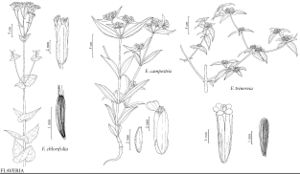Difference between revisions of "Flaveria trinervia"
Contr. U.S. Natl. Herb. 6: 810. 1901.
FNA>Volume Importer |
FNA>Volume Importer |
||
| Line 11: | Line 11: | ||
|name=Odera trinervia | |name=Odera trinervia | ||
|authority=Sprengel | |authority=Sprengel | ||
| + | |rank=species | ||
|publication_title=Bot. Gart. Halle, | |publication_title=Bot. Gart. Halle, | ||
|publication_place=63. 1800 | |publication_place=63. 1800 | ||
| Line 39: | Line 40: | ||
-->{{#Taxon: | -->{{#Taxon: | ||
name=Flaveria trinervia | name=Flaveria trinervia | ||
| − | |||
|authority=(Sprengel) C. Mohr | |authority=(Sprengel) C. Mohr | ||
|rank=species | |rank=species | ||
| Line 54: | Line 54: | ||
|publication year=1901 | |publication year=1901 | ||
|special status= | |special status= | ||
| − | |source xml=https://jpend@bitbucket.org/aafc-mbb/fna-data-curation.git/src/ | + | |source xml=https://jpend@bitbucket.org/aafc-mbb/fna-data-curation.git/src/eaa6e58056e40c9ef614d8f47aea294977a1a5e9/coarse_grained_fna_xml/V19-20-21/V21_619.xml |
|tribe=Asteraceae tribe Heliantheae | |tribe=Asteraceae tribe Heliantheae | ||
|subtribe=Asteraceae (tribe Heliantheae) subtribe Flaveriinae | |subtribe=Asteraceae (tribe Heliantheae) subtribe Flaveriinae | ||
Revision as of 19:38, 16 December 2019
Annuals, to 200+ cm (delicate or robust, glabrate or glabrous). Stems erect. Leaves petiolate (proximal, petioles 10–20 mm) or sessile (distal); blades lanceolate or oblanceolate to elliptic or subovate, 30–150 × (7–)10–40 mm, bases (distal) connate, margins serrate, serrate-dentate, or spinulose-serrate. Heads 30–300+, in tight, axillary, sessile glomerules (receptacles of glomerules setose). Calyculi 0. Involucres oblong and cylindric or angular, 3.8–4.5 mm. Phyllaries usually 2, oblong (closely investing and falling with mature cypselae). Ray florets 0–1; laminae pale yellow or whitish, oblique or suborbiculate, 0.5–1 mm. Disc florets 0–1(–2); corolla tubes 0.5–1.4 mm, throats campanulate, 0.5–0.8 mm. Cypselae oblanceoloid to subclavate, 2–2.6 mm (rays longer); pappi 0. 2n = 36.
Phenology: Flowering Mar–Dec.
Habitat: Near water, saline and gypseous areas
Elevation: 0–1900 m
Distribution

Ariz., Calif., Fla., Mass., Mo., N.Mex., Tex., Va., West Indies, Central America (British Honduras), South America (Brazil, Ecuador, Peru, Venezuela), probably introduced in Asia (India, Middle East), Africa, Pacific Islands (Hawaii).
Discussion
Flaveria trinervia is widespread and weedy; it often occurs in saline, gypseous, disturbed areas near permanent or ephemeral water sources in southern Florida and from Texas to southern California. It occurs also in scattered locations in some eastern states and has been reported from Alabama.
The heads of Flaveria trinervia, which usually contain just one floret, are either radiate or discoid; radiate heads tend to occur on the periphery of setose glomerules. Reduction of some of the floral features, including number of florets [0–1(–2)], phyllaries per head (2), and size of ray laminae, suggest that F. trinervia may be the most derived species in the genus.
Selected References
None.
